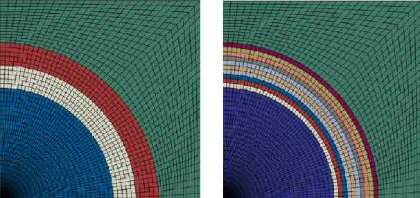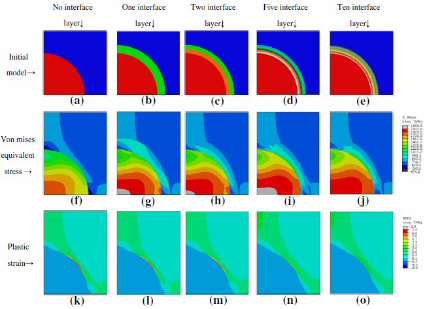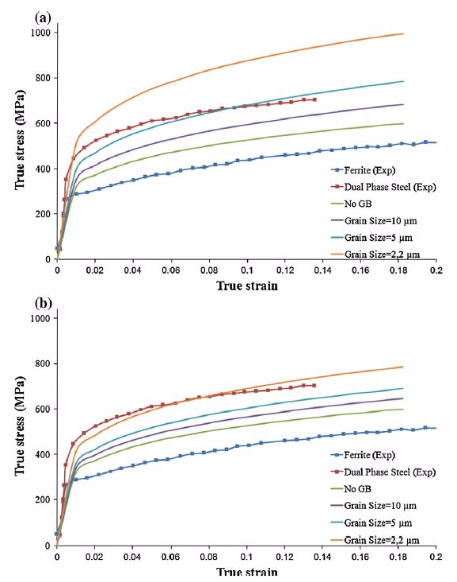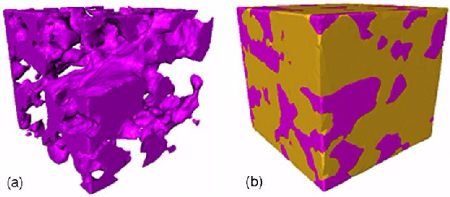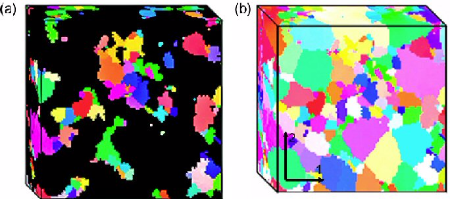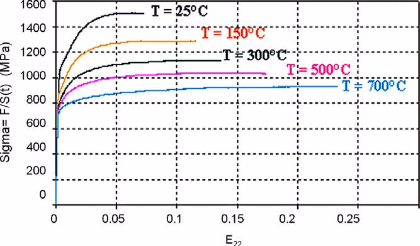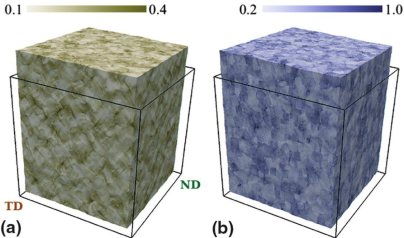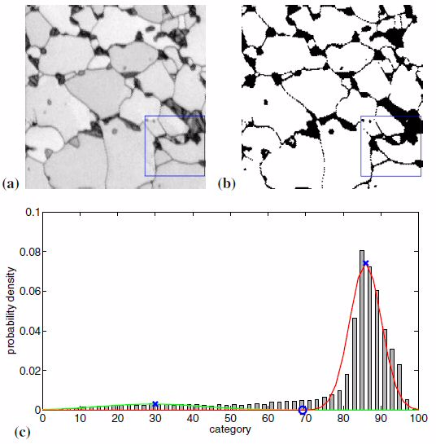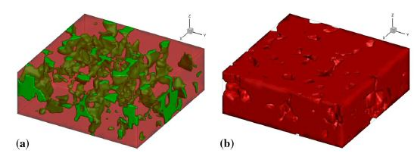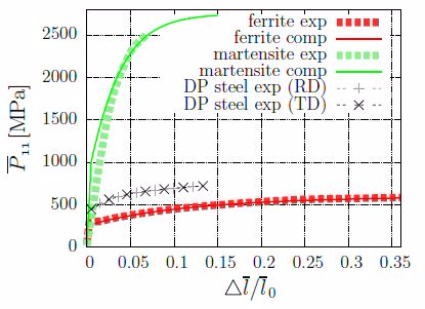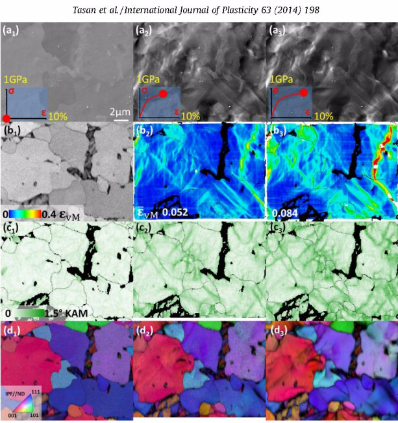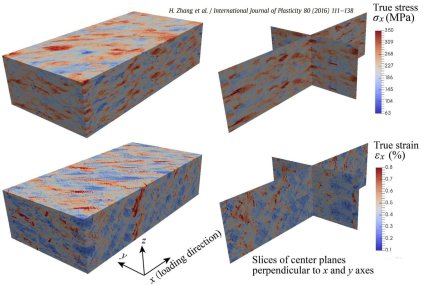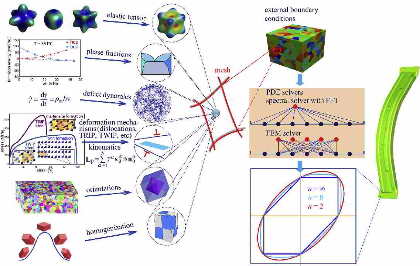RVE and Homogenization Modeling
Experimental and numerical study on geometrically necessary dislocations and non-homogeneous mechanical properties of the ferrite phase in dual phase steels
The microstructure of dual phase steels can be compared with a composite composed of a matrix of ferrite reinforced by small islands of martensite. This assumption has been used in several attempts to model the mechanical properties of dual phase steels. However, recent measurements show that the properties of the ferrite phase change with distance from the martensite grains. These measurements showed that the grains of the ferrite phase are harder in the vicinity of martensite grains. As a consequence of this local hardening effect, the ferrite phase has to be considered as an inhomogeneous matrix in modeling dual phase steels. This experiment inspired the idea that local hardening is caused by geometrically necessary dislocations. The idea is investigated experimentally and numerically in the present analysis, which for the first time leads to good agreement with experimental observations of the mechanical stress–strain behavior.
Acta Materialia 59 (2011) 4387–4394
Acta Mater 2011 dual phase steel GND sim[...]
PDF-Dokument [1.7 MB]
Polycrystal model of the mechanical behavior of a Mo–TiC30 vol.% metal–ceramic composite using a three-dimensional microstructure map obtained by dual beam focused ion beam scanning electron microscopy
The mechanical behavior of a Mo–TiC30 vol.% ceramic–metal composite was investigated over a wide temperature range (25–700 °C). High-energy X-ray tomography was used to reveal percolation of
the hard titanium carbide phase through the composite. Using a polycrystal approach for a two-phase material, finite-element simulations were performed on a real three-dimensional (3-D)
aggregate of the material. The 3-D microstructure, used as the starting configuration for the predictions, was obtained by serial sectioning in a dual beam focused ion beam scanning
electron microscope coupled to an electron backscattered diffraction system. The 3-D aggregate consists of a
molybdenum matrix and a percolating TiC skeleton. As for most body-centered cubic (bcc) metals, the molybdenum matrix phase is characterized by a change in plasticity mechanism with temperature.
We used a polycrystal model for bcc materials which was extended to two phases (TiC and Mo). The model parameters of the matrix were determined from experiments on pure molydenum. For all
temperatures investigated the TiC particles were considered to be brittle. Gradual damage to the TiC particles was treated, based on an accumulative failure law that is approximated by
evolution of the apparent particle elastic stiffness. The model enabled us to determine the
evolution of the local mechanical fields with deformation and temperature. We showed that a 3-D aggregate representing the actual microstructure of the composite is required to understand the
local and global mechanical properties of the composite studied.
Acta Materialia 60 (2012) 1623–1632
Acta Materialia 60 (2012) 1623-Mo-polycr[...]
PDF-Dokument [1.6 MB]
How to combine DREAM.3D with Crystal Plasticity Representative Volume Element Simulations and DAMASK
Predicting, understanding, and controlling the mechanical behavior of complex polycrystalline materials is the most important task when designing structural materials. Modern alloy systems—in which multiple deformation mechanisms, phases, and defects are introduced to overcome the inverse strength–ductility relationship—give raise to multiple possibilities for modifying the deformation behavior, rendering traditional, exclusively experimentally-based alloy development workflows inappropriate.
For fast and efficient alloy design, it is therefore desirable to predict the mechanical performance of candidate alloys by simulation studies to replace time- and resource-consuming mechanical tests. Simulation tools suitable for this task need to correctly predict the mechanical behavior in dependence of alloy composition, microstructure, texture, phase fractions, and processing history. Here, an integrated computational materials engineering approach based on the open source software packages DREAM.3D and DAMASK (Düsseldorf Advanced Materials Simulation Kit) that enables such virtual material development is presented.
More specific, our approach in combining DREAM.3D and DAMASK (Düsseldorf Advanced Materials Simulation Kit) consists of the following three steps:
(1) acquire statistical quantities that describe a microstructure,
(2) build a representative volume element based on these quantities employing DREAM.3D, and
(3) evaluate the representative volume using a predictive crystal plasticity material model provided by DAMASK.
Dream 3D and DAMASK crystal plasticity i[...]
PDF-Dokument [2.4 MB]
Computational modeling of dual-phase steels based on representative three-dimensional microstructures obtained from EBSD data
The microstructure of dual-phase steels consisting of a ferrite matrix with embedded martensite inclusions is the main contributor to the mechanical properties such as high ultimate tensile strength, high work hardening rate, and good ductility.
Due to the composite structure and the wide field of applications
of this steel type, a wide interest exists in corresponding virtual computational experiments. For a reliable modeling, the microstructure should be included. For that reason, in this paper we
follow a computational strategy based on the definition of a representative volume element (RVE). These RVEs will be constructed by a set of tomographic measurements and mechanical tests. In order to arrive at more efficient numerical schemes, we also construct statistically similar RVEs, which are
characterized by a lower complexity compared with the real microstructure but which represent the overall material behavior accurately. In addition to the morphology of the microstructure,
the austenite–martensite transformation during the steel production has a
relevant influence on the mechanical properties and is considered in this contribution. This transformation induces a volume expansion of the martensite phase. A further effect is determined in
nanoindentation test, where it turns out that the hardness in the ferrite phase increases exponentially when approaching the
martensitic inclusion. To capture these gradient properties in the computational model, the volumetric expansion is applied to the martensite phase, and the arising equivalent plastic strain distribution in the ferrite phase serves
as basis for a locally graded modification of the ferritic yield curve. Good accordance of the model considering the gradient yield behavior in the ferrite phase is observed in the
numerical simulations with experimental data.
Arch Appl Mech
DOI 10.1007/s00419-015-1044-1
DP steel AAM_2015.pdf
PDF-Dokument [2.4 MB]
The mechanical response of multiphase alloys is governed by the microscopic strain and stress partitioning behavior among microstructural constituents. However, due to limitations in the
characterization of the partitioning that takes place at the submicron scale, microstructure optimization of such alloys is typically based on evaluating the averaged response, referring to, for
example, macroscopic stress–strain curves. Here, a novel experimental–numerical methodology is introduced to strengthen the integrated understanding of the
microstructure and mechanical properties of these alloys, enabling joint analyses of deformation-induced evolution of the microstructure, and the strain and stress distribution therein, down to
submicron resolution. From the experiments, deformation-induced evolution of (i) the microstructure, and (ii) the local strain distribution are concurrently captured, employing in situ secondary
electron imaging and electron backscatter diffraction (EBSD) (for the former), and microscopic-digital image correlation (for
the latter). From the simulations, local strain as well as stress distributions are revealed, through 2-D full-field crystal plasticity
(CP) simulations conducted with an advanced spectral solver suitable for heterogeneous materials. The simulated model is designed directly from the initial EBSD measurements, and the phase properties are obtained by additional inverse CP simulations of nanoindentation experiments carried out on the original microstructure. The experiments and simulations demonstrate good correlation in the proof-of-principle
study conducted here on a martensite–ferrite dual-phase steel, and deviations are discussed in terms of limitations of the
techniques involved. Overall, the presented integrated computational materials engineering approach provides a vast amount of
well-correlated structural and mechanical
data that enhance our understanding as well as the design capabilities of multiphase alloys.
Acta Materialia 81 (2014) 386–400
Acta Mater 81 (2014) 386 stress strain p[...]
PDF-Dokument [1.6 MB]
A digital twin for efficient yield surface simulation in metal forming using a DAMASK-based crystal plasticity spectral method
In this project we present a virtual laboratory to investigate the anisotropic yield behavior of polycrystalline materials by using high resolution crystal plasticity simulations. Employing a fast spectral method solver enables us to conduct a large number of full-field virtual experiments with different stress states to accurately identify the yield surface of the probed materials. Based on the simulated yield stress points, the parameters for many commonly used yield functions are acquired simultaneously with a nonlinear least square fitting procedure. Exemplarily, the parameters of four yield functions frequently used in sheet metal forming, namely Yld91, Yld2000-2D, Yld2004-18p, and Yld2004-27p are adjusted to accurately describe the yield behavior of an AA3014 aluminum alloy at two material states, namely with a recrystallization texture and a cold rolling texture. The comparison to experimental results proves that the methodology presented, combining accuracy with efficiency, is a promising micromechanics-based tool for probing the mechanical anisotropy of polycrystalline metals and for identifying the parameters of advanced yield functions.
International Journal of Plasticity 80 (2016) 111-138
Here we present a virtual laboratory to investigate the anisotropic yield behavior of polycrystalline materials by using high resolution crystal plasticity simulations.
Intern J Plasticity 80 (2016) 111 Zhang [...]
PDF-Dokument [5.3 MB]
Qith this approach a large number of virtual tests with randomly generated deformation modes were performed by using the DAMASK-based virtual laboratory. The predicted yield stress points were used to identify the parameters of a set of different yield functions. In addition, uniaxial tensile tests in
different directions were also performed by using the virtual laboratory to obtain both, the deformation anisotropy (r-values) and the strength anisotropy (normalized yield stresses, Yq). The
results of virtual uniaxial tension demonstrate that the virtual laboratory is capable of replacing the mechanical tests that are typically required to extract the r-values and Yq. Although only
yield stresses but no r-value and Yq values were used to identify the parameters, the identified yield functions, i.e., Yld2000-2D, Yld2004-18p, and Yld2004-27p show good performance in fitting
the yield surfaces, r-values, and Yq simultaneously. In contrast, the Yld91 yield function, due to a smaller number of required parameters, shows good performance in fitting yield surfaces but
relatively poor capability in the prediction of r-values and Yq. The virtual laboratory simulations and the experimental results show that the presented approach, which combines both accuracy
and
efficiency, is a promising micromechanical-based tool for the investigation of mechanical anisotropy of metals and for the parameter identification of advanced yield functions.
The approach also shows that an efficient multiscale modeling connection can be established between full-field physically based constitutive CP modeling on the one hand and engineering anisotropy
simulations on the other hand by using the open source DAMASK toolbox (http://damask.mpie.de/).
This type of CP-based scale bridging simulation is important since sheet metal forming simulations that are based on yield surface functions must be designed in a way that allows users to fit them to the underlying physics that governing plastic deformation of complex engineering materials. In this study we have shown that this type of cross-scale simulation fulfills the requirement to fit arbitrary yield function parameters by using any kind of specific constitutive
CP models that considers complex textures and adequately reflects the underlying deformation mechanisms.

